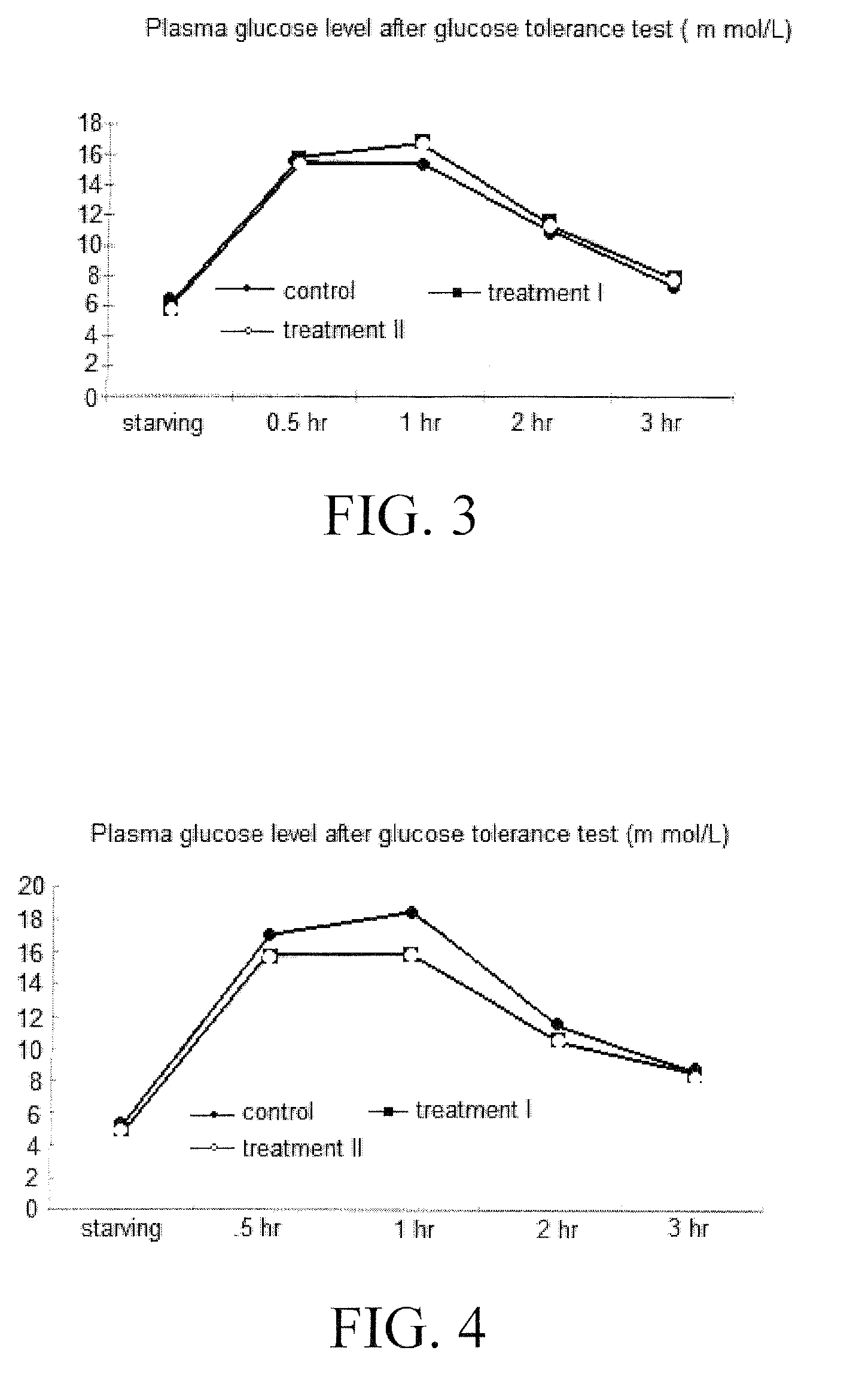Materials and Methods for Modulating Metabolism
a technology of metabolism and materials, applied in the field of materials and methods for modulating metabolism, can solve the problems of cholesterol suppressing the cell's synthesis of new, reducing the synthesis of hmg-coa reductase, and potentially lethal, and achieves the effects of increasing glucose transporter (glut4) expression, reducing insulin-like growth factor 1 (igf-1), and reducing c peptid
- Summary
- Abstract
- Description
- Claims
- Application Information
AI Technical Summary
Benefits of technology
Problems solved by technology
Method used
Image
Examples
example 1
[0092]Nineteen male Goto-Kakizaki Wistar rats (GK rats) with weights of 300±20 g were kept in steel cages, 3-4 rats per cage. The cages were changed every two days. Indoor temperature and relative humidity was kept at 23±3° C. and 65±1% respectively. Feed and drinking water was provided. GK rats were permitted a one-month period for adaptation. When the GK rats all demonstrated symptoms of diabetes (i.e., frequent eating, frequent drinking, frequent urination, and high plasma glucose and insulin resistance), they were randomly divided into 3 groups: 7 rats in a control group; 6 rats each in treatment I and II groups.
Prephase Period
[0093]One day prior to experimentation, at 17:00, all of the feed was removed from all groups, but not the drinking water. On the second day, at 09:30, starving plasma glucose was measured for all GK rats. At 10:00, glucose tolerance test (2 g / kg BW) was performed and the plasma glucose level was measured as well for all GK rats. On the third day, the GK r...
example 2
Effects of Concurrent Administration of Metfornin and a Cysteamine Compound on Non-Diabetic Rats
[0099]Thirty-two male Wistar rats (purchased from Shanghai Slaccas Laboratory Animal Center) aged about 13 weeks and weighting around 300 g were acclimated to the animal facility for two weeks in individual cages. Food and water were provided ad libitum.
[0100]The Wistar rats were divided randomly into 4 groups and each group contained 8 rats. Group 1 (control, n=8) was treated with saline by gavage (2 ml / rat); Group 2 (DC15, n=8) was treated with cysteamine hydrochloride by gavage (15 mg / kg body-weight (BW) in 2 ml tap water); Group 3 (DC22.5, n=8) was treated with cysteamine hydrochloride by gavage (22.5 mg / kg BW in 2 ml tap water); Group 4 (DC30, n=8) was treated with cysteamine hydrochloride by gavage (30 mg / kg BW in 2 ml tap water). All animals were treated at 10:00 for 27days.
[0101]The four groups of animals were kept in the same room in different cages with wire mesh bottoms to redu...
example 3
Effect of Concurrent Administration of Metformin (at a Higher Dose Than That of Example 1) and a Cysteamine Compound on Diabetic Rats
[0105]Thirty-six Goto-Kakizaki Wistar (GK) rats (purchased from Shanghai Slaccas Laboratory Animal Center) aged about 13 weeks and weighting 321-323 g were acclimated to the animal facility for two weeks in individual cages. Food and water were provided ad libitum.
[0106]The 36 GK rats were divided into 4 groups based on body weight (BW) and plasma glucose level. Group 1 (control, n=10) was treated with saline by gavage (2 ml / rat); Group 2 (DC, n=6) was treated with cysteamine hydrochloride by gavage (22.5 mg / kg BW in 2 ml tap water); Group 3 (Metformin, Met, n=10) was treated with Metformin by gavage (34 mg / kg BW in 2ml tap water); Group 4 (Met+DC, n=10) was treated with Metformin 34 mg / kg BW / day in 2 ml tap water for the first 10 days and then was treated with both cysteamine hydrochloride 22.5 mg / kg BW plus Metformin 34 mg / kg BW in 2 ml tap water for...
PUM
| Property | Measurement | Unit |
|---|---|---|
| diameter | aaaaa | aaaaa |
| body weight | aaaaa | aaaaa |
| weights | aaaaa | aaaaa |
Abstract
Description
Claims
Application Information
 Login to View More
Login to View More - R&D
- Intellectual Property
- Life Sciences
- Materials
- Tech Scout
- Unparalleled Data Quality
- Higher Quality Content
- 60% Fewer Hallucinations
Browse by: Latest US Patents, China's latest patents, Technical Efficacy Thesaurus, Application Domain, Technology Topic, Popular Technical Reports.
© 2025 PatSnap. All rights reserved.Legal|Privacy policy|Modern Slavery Act Transparency Statement|Sitemap|About US| Contact US: help@patsnap.com



